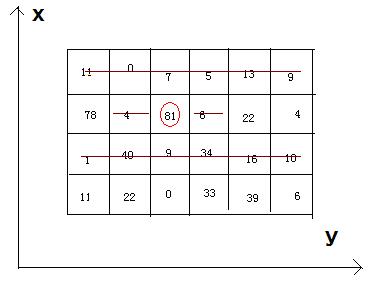吃土豆
来源:互联网 发布:执业药师网络报名机构 编辑:程序博客网 时间:2024/06/10 19:38

Now, how much qualities can you eat and then get ?
- 输入
- There are a few cases. In each case, there are two integer M (row number) and N (column number). The next M lines each contain N integers, representing the qualities of the beans. We can make sure that the quality of bean isn't beyond 1000, and 1<=M,N<=500.
- 输出
- For each case, you just output the MAX qualities you can eat and then get.
- 样例输入
4 611 0 7 5 13 978 4 81 6 22 41 40 9 34 16 1011 22 0 33 39 6
- 样例输出
242
解题思路:对于每一行,即求最大不连续子序列和求得每一行的最大不连续子序列和后,根据题目要求,对于矩阵的每一行都不连续,同样是一个最大不连续子序列和的问题。
AC代码如下:
#include <stdio.h>int a[500], b[500];int maxSubSeq(int a[], int size){ if(size == 1) return a[0]; if(size == 2) return a[0] > a[1] ? a[0] : a[1]; int dpi, dpi_1, dpi_2; dpi_2 = a[0]; dpi_1 = a[0] > a[1] ? a[0] : a[1]; for(int i=2; i<size; i++) { int t = dpi_2 + a[i]; dpi = t > dpi_1 ? t : dpi_1; dpi_2 = dpi_1; dpi_1 = dpi; } return dpi;}int main(){ int m, n; while(scanf("%d %d", &m, &n) == 2) { for(int i=0; i<m; i++) { for(int j=0; j<n; j++) { scanf("%d", &a[j]); } b[i] = maxSubSeq(a, n); } printf("%d\n", maxSubSeq(b, m)); } return 0;} - 吃土豆
- 吃土豆
- 吃土豆
- 吃土豆
- 吃土豆
- 吃土豆
- 土豆“十五”吃
- 题目234 吃土豆
- nyoj 234 吃土豆
- Nyoj 234 吃土豆
- NYOJ234吃土豆
- nyoj 234 吃土豆
- NYOJ-234-DP(吃土豆)
- NYOJ 吃土豆(动态规划)
- NYOJ 题目234 吃土豆
- nyoj234 吃土豆 01背包
- NYOJ234-吃土豆(双层DP)
- nyoj-234-吃土豆(动态规划)
- 7.编码剖析Spring依赖注入的原理
- 运维工具
- cocos2d-x 5种常用CCMenuItem
- Winning the Netflix Prize: A Summary
- poj 2374
- 吃土豆
- java 把url传参的汉字变成%百分号形式,<c:url><c:param>,url提交汉字乱码
- 当你对未来迷茫的时候,请打开这个锦囊!
- 单链表的逆置
- 杂记--随时更新
- 【Hibernate】Hibernate的检索策略:lazy、fetch
- 黑马程序员_面试题之交通灯
- Struts2开发步骤
- 动态代理代码实现实例


